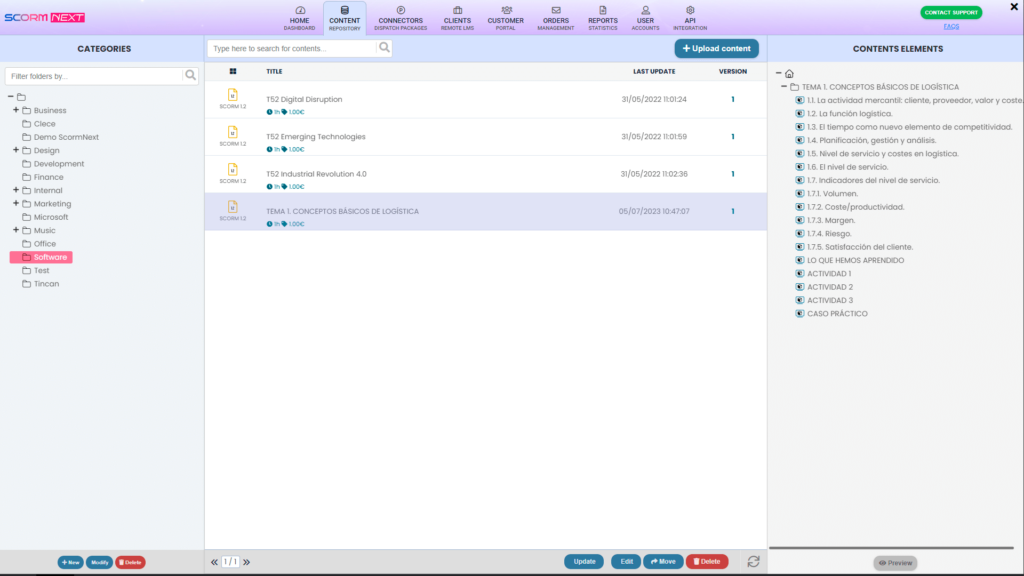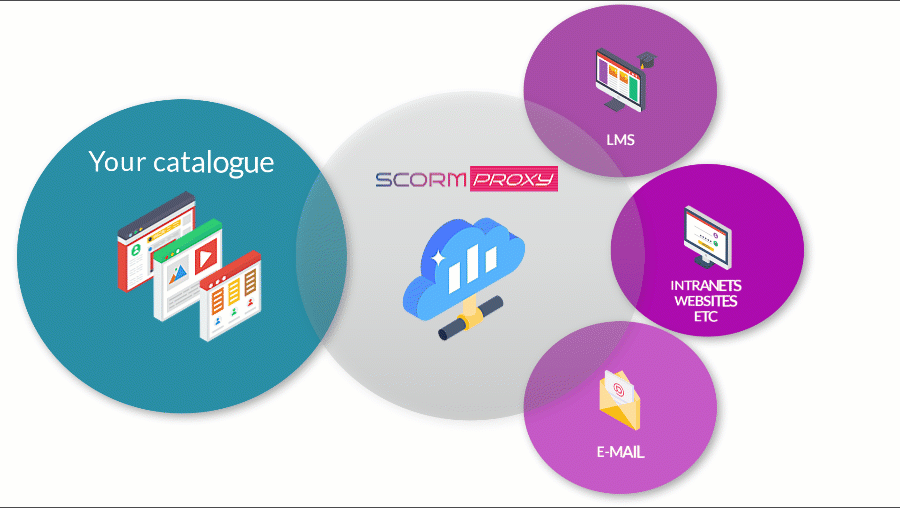Understanding the SCORM Cross-Domain Issue in E-Learning
Introduction: What is SCORM?
SCORM, or Sharable Content Object Reference Model, is a widely adopted standard in the world of e-learning. Developed by the Advanced Distributed Learning (ADL) initiative, SCORM enables interoperability between e-learning content and Learning Management Systems (LMS). Essentially, SCORM acts as a bridge between e-learning content modules and the LMSs that host them, ensuring that content can be launched, tracked, and shared across platforms seamlessly. The goal of SCORM is to ensure that educational content can be reused across different learning platforms without compatibility issues, which makes it a vital component for organizations that create or distribute digital learning resources.
The core strength of SCORM lies in its ability to track the learner’s progress, ensuring that each activity within an online course is recorded properly. This includes data such as the learner’s quiz scores, time spent on each section, and completion status. SCORM helps build a consistent experience, allowing e-learning developers to create dynamic content that interacts well with multiple LMS environments.
However, despite its adaptability, SCORM does come with certain challenges, particularly when content is hosted on a different domain from the LMS that launches it. This issue is known as the cross-domain problem.
What is Cross-Domain?
The term cross-domain refers to the interaction between web resources that reside on different domains. For example, if an LMS, which is hosted at “https://www.examplelms.com,” attempts to access content hosted at “https://www.examplecontent.com,” this constitutes a cross-domain request. In the context of e-learning, cross-domain requests are common when organizations wish to host SCORM content separately from their LMS for security, performance, or content management reasons.
Web browsers, however, implement a security policy called Same-Origin Policy. This policy restricts scripts on a web page from making requests to a different domain than the one that served the web page. The Same-Origin Policy exists to prevent malicious actions, such as cross-site scripting (XSS), where a script on one site can potentially steal or manipulate information from another. As a result, cross-domain issues arise when a SCORM package hosted on a different domain attempts to communicate with the LMS, causing communication failures between the two systems.
The Problem with SCORM and Cross-Domain
SCORM content relies heavily on JavaScript to communicate with the LMS, which poses a challenge when the content and LMS are on separate domains. When SCORM content attempts to establish a communication bridge with the LMS, the browser’s Same-Origin Policy prevents the content from accessing LMS functions, ultimately breaking the intended functionality.
The primary issue here is that SCORM-based JavaScript attempts to execute functions like “LMSInitialize()” or “LMSCommit()” across domains, but these functions are blocked by the browser for security reasons. As a result, learners may experience various problems, such as the inability to launch content, tracking errors, and progress that isn’t saved. This issue can create a disjointed user experience and lead to a lot of frustration, both for learners who lose their progress and for content providers who have to deal with technical support and workarounds.
Consider a typical scenario in which a company sells SCORM packages to clients who use different LMSs. The content developer might want to host all learning material on their own server for easier updates and maintenance. When a client tries to launch the content from their LMS, the cross-domain policy prevents SCORM from communicating correctly, resulting in errors that undermine the value of the entire learning experience.
How the Cross-Domain Issue Affects E-Learning Content Providers
The SCORM cross-domain problem significantly impacts organizations that develop and distribute e-learning content. Many content providers prefer to centralize their content for reasons such as control, security, and simplified updates. If each client’s LMS requires local copies of the SCORM packages, maintaining and updating those copies can become a logistical nightmare, especially when frequent content updates are necessary.
1. Maintenance and Version Control
Without a cross-domain solution, content providers are forced to distribute SCORM content to each client, which means they need to track different versions of their content across many LMS installations. This decentralized approach can lead to inconsistencies, outdated content being used, and even legal liabilities if certifications or compliance modules are not updated.
2. Security Concerns
Many content providers do not want to hand over their proprietary training content to clients. Hosting the SCORM content on the provider’s server means retaining control over the content and ensuring that only authorized users can access it. However, cross-domain issues prevent this from being easily implemented, forcing content providers to choose between giving up control or dealing with broken functionality.
3. Administrative Overhead
Manually updating and supporting different versions of content for each client adds significant administrative burden. It is not only labor-intensive but also prone to errors. A centralized solution is much more efficient, allowing content developers to make updates in one place and have those changes instantly reflected for all clients.
Introducing the Solution: scormPROXY
To address the challenges posed by cross-domain restrictions, scormPROXY offers a practical solution that effectively bridges the gap between SCORM content and various LMS platforms, even if they are on different domains. scormPROXY enables content to remain hosted on a separate server from the LMS, without being subject to the same-origin policy restrictions, allowing the SCORM communication to function as intended.
scormPROXY functions as an intermediary that facilitates secure communication between SCORM content and the LMS, effectively circumventing the cross-domain limitations imposed by browsers. This enables organizations to centralize their content, maintain version control, and easily distribute learning modules without sacrificing the user experience.
The technology behind scormPROXY creates an environment where SCORM content can communicate seamlessly with any LMS, regardless of where the content is hosted. It works by creating a secure bridge that allows data to flow between the LMS and the hosted content without triggering browser security alerts.

How scormPROXY Solves the Cross-Domain Problem
1. Centralized Content Management
With scormPROXY, content developers can keep all their SCORM packages on a single server, simplifying version control and updates. Since scormPROXY ensures compatibility across LMS platforms, updates made to the content are instantly available to all users. This ensures that learners always have access to the latest version, while organizations can rest assured that they are providing up-to-date and compliant learning materials.
2. Security Assurance
scormPROXY addresses the security concerns related to cross-domain interactions. By acting as a proxy, it prevents direct access to the LMS from the SCORM content, mitigating security risks that arise from exposing APIs directly to multiple client systems. Content providers can rest assured that their material is protected while maintaining the ability to distribute it widely.
3. Seamless Learner Experience
The ultimate goal of scormPROXY is to provide a seamless learning experience for the end-user. Learners can launch SCORM content directly from their LMS without any disruptions or tracking issues caused by cross-domain communication errors. scormPROXY makes the learning experience smooth and straightforward, with reliable tracking of all learning activities.
How scormPROXY Can Benefit Your Organization
If your organization develops or distributes SCORM content, scormPROXY can be a game-changer by eliminating the barriers associated with cross-domain policies. Here’s how scormPROXY can add value:
1. Simplified Content Updates
scormPROXY allows you to maintain all of your SCORM content in one place, which means that updates only need to be made once. This eliminates the need to re-upload new versions to multiple LMSs, ensuring consistency across all client deployments.
2. Reduced Costs
By eliminating the need to create and maintain multiple versions of content for different clients, scormPROXY can help reduce administrative and development costs. You can focus on developing high-quality content, rather than spending time troubleshooting deployment issues.
3. Improved Control and Compliance
Centralizing SCORM content with scormPROXY allows you to maintain better control over access, ensuring that only authorized users are able to view or interact with your content. This is especially critical for compliance-related training, where it’s vital that only current, approved versions of training materials are used.
4. Enhanced Security
By keeping SCORM content centralized and communicating through scormPROXY, you minimize security risks, as content is not distributed across multiple client servers. You retain control over your intellectual property and reduce the risk of unauthorized access or modifications.
5. Better Scalability
scormPROXY makes it much easier to scale your business. When onboarding a new client, you simply grant them access to your existing content instead of re-packaging and redeploying files. This efficiency can help you expand your reach without proportionally increasing your workload.
Illustrative Diagram
Below is a simplified illustration that demonstrates how scormPROXY acts as an intermediary between the LMS and the SCORM content, allowing seamless communication between different domains.

Figure 1: scormPROXY as a solution for cross-domain SCORM content communication
Conclusion
SCORM is an incredibly powerful standard for ensuring interoperability between e-learning content and LMS platforms, but it has inherent limitations when it comes to cross-domain communication. These limitations can be a significant pain point for e-learning providers who wish to centralize their content and streamline updates. The cross-domain issue not only creates logistical challenges but also diminishes the overall learner experience by preventing smooth content delivery and tracking.
scormPROXY solves these problems by acting as a bridge between SCORM content and LMS platforms, regardless of domain restrictions. It provides a secure, centralized solution that reduces administrative overhead, enhances security, and provides a seamless learning experience for the end-user. Organizations that embrace scormPROXY can leverage its advantages to focus on content quality, security, and scalability—ultimately delivering better learning experiences to clients and users alike.
If your organization is looking for a robust way to distribute SCORM content across multiple clients while retaining control, scormPROXY could be the ideal solution to help you achieve your goals. Feel free to reach out to us to learn more about how scormPROXY can transform your e-learning strategy.
